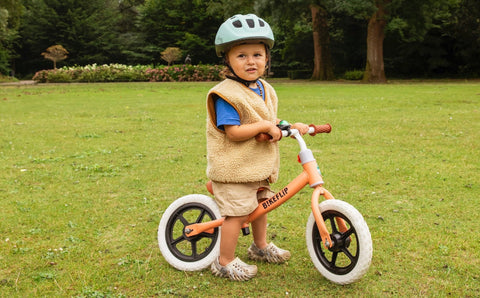Cycling is a fantastic activity for children; it not only promotes their physical health, but also their independence and awareness in traffic. Unfortunately, thousands of bicycle accidents occur each year in which children are injured. Many of these injuries involve the head, which can lead to serious and long-term consequences. Wearing a helmet is a simple and effective way to reduce the risks. In this blog, we share why wearing a helmet is so important, supported by facts, and provide tips on choosing the right helmet.
The Importance of a Bicycle Helmet: Facts and Figures
- Accident Protection : Studies show that wearing a helmet reduces the risk of serious head injuries by 60-85%. A fall on the head without a helmet can lead to serious injuries, such as concussion or even brain damage. It is important to remember that a helmet loses some of its protective character after a fall or collision. It is therefore good to always check the helmet after your child has fallen or had a collision.
- Risk of head and brain injury : According to research by VeiligheidNL children are at increased risk of head injuries in bicycle accidents. In the Netherlands, approximately 5,000 children are hospitalized each year after a bicycle accident, many of whom sustain head injuries.
- Risks at lower speeds: Many parents think that helmets are only necessary at higher speeds or on busy roads, but even a fall at low speed can be enough to cause a concussion or skull fracture. Children often cycle in a playful way and are not yet fully aware of traffic risks, which makes wearing a helmet all the more important.
Tips for choosing the right helmet for your child
Not every helmet offers the same level of protection and comfort. When choosing a bike helmet for your child, there are a few important aspects to keep in mind:
- Safety Marks: Check that the helmet has an approved mark, such as the European EN 1078 mark. This indicates that the helmet meets the European safety standards for bicycle helmets.
- Fit and size: A helmet must fit properly to be effective. Measure your child's head circumference and choose a helmet that is appropriate for that size. A helmet that is too big or too small will not provide sufficient protection. The helmet should fit securely, without shifting, but also not be too tight. A fun way to test this is to have your child shake their head and see if the helmet fits properly and does not shift too much.
- Adjustability: Choose a helmet with adjustable straps and a dial at the back so the helmet can be adjusted properly. This ensures that the helmet always fits properly, even as your child grows or wears different hairstyles.
- Comfort and ventilation: Pay attention to the comfort of the helmet. Helmets with ventilation holes ensure that your child's head stays cool, which makes wearing the helmet more pleasant, especially on longer bike rides.
- Helmet Weight: A helmet that is too heavy can be uncomfortable for a child and can even cause your child's head to lean forward. So choose a lightweight helmet, specially designed for children.
- Reflective elements or bright colours: For extra visibility in traffic, it is a good idea to choose a helmet with reflective details or in a bright colour. This makes your child more visible to other road users, especially on dark autumn and winter days.
How to motivate children to wear a helmet
It can sometimes be a challenge to get kids excited about wearing helmets, especially if their friends don’t wear helmets. Here are some tips to encourage helmet use:
- Let kids choose their helmet: Give your child some freedom in choosing a helmet. Together, choose a color or a fun pattern that appeals to them, so that the helmet becomes a personal favorite.
- Set a good example: Children tend to copy their parents. If you wear a helmet yourself, they will be more likely to do the same.
- Make it a game: Calling the helmet a “protective helmet” or “superhero helmet” can make wearing it more appealing to younger children.
Conclusion: Safety first, every bike ride
Wearing a helmet can make the difference between a minor fall and a serious injury. By investing in a good helmet and teach children the importance of safety, we can help them to cycle with fun and confidence. A helmet is more than an accessory; it is an important protective measure that keeps children safe during their cycling adventures. By combining a helmet with other accessories such as a bicycle bell or a flag, you can ensure that your child is clearly seen and can safely go on their cycling adventure!




